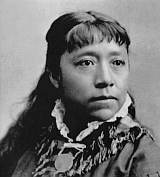Fort McDermitt Paiute and Shoshone Tribe facts for kids

Sarah Winnemucca, a Northern Paiute activist and author, worked as an interpreter, scout and hospital matron at Fort McDermit from 1868 to 1873.
|
|
| Total population | |
|---|---|
| 689 enrolled members (1992) 341 residents on reservation (2010) |
|
| Regions with significant populations | |
( |
|
| Languages | |
| Northern Paiute language, English | |
| Religion | |
| Christianity, Sun Dance, Native American Church, Traditional Unity Movement | |
| Related ethnic groups | |
| Southern Paiute and Western Shoshone peoples |
The Fort McDermitt Paiute and Shoshone Tribe is a federally recognized tribe of Northern Paiute and Western Shoshone peoples, whose reservation Fort McDermitt Paiute and Shoshone Tribes of the Fort McDermitt Indian Reservation spans the Nevada and Oregon border next to Idaho. The reservation has 16,354 acres (6,618 ha) in Nevada and 19,000 acres (7,700 ha) in Oregon.
Peoples from these two tribes have historically also lived in what is now defined as southwestern Idaho. They are close culturally and linguistically to the Bannock people and various other Shoshone-language peoples. Peoples of these tribes are members of other federally recognized tribes in Nevada and Idaho.
In October 2016 a federal law was passed to put approximately 19,094 acres of Bureau of Land Management (BLM) land into trust for the Tribe in order to expand their reservation; this was done under the Nevada Native Nations Land Act. Gaming is prohibited on the new lands.
Reservation
The Fort McDermitt Indian Reservation spans the Nevada–Oregon border, in Humboldt County, Nevada and Malheur County, Oregon, near the Quinn River, which runs east to west through the Tribe's Nevada lands. Just to the east is southwestern Idaho. The Fort McDermitt Military Reservation was established 14 August 1865 at the former site of Quinn River Camp No. 33 and a stagecoach stop, Quinn River Station, in what was a traditional seasonal homeland of the Paiute, Shoshone and Bannock peoples.
Originally the fort was established to protect the stagecoach route from Virginia City through Winnemucca, Nevada to Silver City, Idaho Territory, in the southwestern part of the area. It was named after Lt. Col. Charles McDermit, commander of the Military District of Nevada, who was killed in a skirmish in the area in 1865.
The Paiute had traditional territory ranging from the Southwest up into Nevada, Oregon and southwestern Idaho. The Paiute in this area became known as the "Northern Paiute." They are related culturally and linguistically to the Shoshone, Bannock and other tribes of the region.
When the military outpost was closed in 1889, the Military Reservation was adapted as the Fort McDermitt Indian Agency. Northern Paiute and Shoshone were settled here. In 1936 the federal government established an Indian reservation to support the tribe's organizing as the Paiute and Shoshone Tribe under the Indian Reorganization Act of 1934. They had to give up their traditional, hereditary chiefs as leaders in favor of an elected, representative form of government.
The reservation was established with 16,354 acres (66.2 km2) in Nevada and 19,000 acres (76.9 km2) in Oregon, mostly areas of arid land. In October 2016 the federal government put into trust for the tribe approximately 19,094 acres (77.3 km2) acres of Bureau of Land Management (BLM) land in Nevada, in order to expand their reservation and give them a more sustainable base. Gaming is prohibited on these new lands. This was done under the Nevada Native Nations Land Act (PL No: 114-232).
Language
The tribe speaks the Northern Paiute language, also known as Paviotso, which is a Western Numic language. Fort McDermitt has the greatest concentration of Northern Paiute speakers among the various locations where they live. 20–30% of the tribe's children can speak the language.
Communities
Notable tribal members and residents
- Sarah Winnemucca
- Chief Winnemucca, also known as Old Winnemucca, Sarah's father and a war leader
- R. Eagleye Johnny, "Can Indian Tribes Afford to Let the Bureau of Indian Affairs Continue to Negotiate Permits & Leases of Their Resources?", American Indian Law Review 16(1): 201-211 (University of Oklahoma, Norman, 1991)
- Erickson, J.D., Chapman D. and R. Eagleye Johnny, "Monitored Retrievable Storage of Spent Nuclear Fuel in Indian Country: Liability, Sovereignty, and Socioeconomics," American Indian Law Review 19(1): 73-103 (University of Oklahoma, Norman, 1994)

